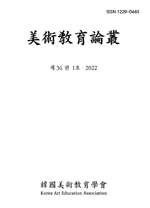- 영문명
- Pedagogical Discourse on the Use of Generative Artificial Intelligence(GAI) in Art Education - Creativity, Ethics, and Practical Challenges -
- 발행기관
- 한국미술교육학회
- 저자명
- 손숙영(Sook Young Son)
- 간행물 정보
- 『미술교육논총』第39券 3號, 176~198쪽, 전체 23쪽
- 주제분류
- 예술체육 > 미술
- 파일형태
- 발행일자
- 2025.09.30

국문 초록
본 연구는 미술교육에서 생성형 인공지능(GAI)의 활용 가능성과 그 교육학적함의를 탐구하였다. 최근 AI 기술은 이미지와 텍스트의 자동 생성 능력을 기반으로창작 영역 전반에 급격한 변화를 가져오고 있으며, 이는 미술교육의 내용·방법· 목표를 재구성하는 계기를 제공한다. 본 연구는 먼저 생성형 AI의 기술적 특징을살펴보고, 창의성 개념의 변화, 포스트휴머니즘과 시뮬라크르, 숭고의 미학 등 철학적· 이론적 논의를 토대로 교육적 맥락을 분석하였다. 특히, 본 연구는 ‘공동 창의성(co-creativity)’ 관점에서 의도·맥락·주체성의 재정을 전제로 교육적 함의를 분석하였다. 이어서 본론에서는 미술교육에서의 다섯 가지 가능성을 도출하였다. 즉, 창의적 표현의 확장, 개별화된 학습 지원, 감상 교육의 심화, 협력적 창의성과소프트 스킬의 증진, 포스트휴머니즘적 생태 감수성의 함양이다. 그러나 동시에저작권 침해와 데이터 편향, 창의성 진정성의 논란, 교육 불평등과 디지털 격차, 교사 역량 부족과 같은 윤리적·교육적 쟁점도 확인되었다. 이에 따라 본 연구는교사의 AI 활용 역량 강화, 참여적 수업 모형 개발, 제도적·정책적 지원, 교육철학적성찰의 필요성을 제언하였다. 본 연구는 문헌 연구를 중심으로 이루어졌다는 한계를지니지만, 향후 AI 기반 미술 수업의 효과성을 실증적으로 검증하고 문화적 맥락에따른 차이를 탐구하는 후속 연구가 필요함을 밝힌다. 종합적으로 생성형 인공지능은미술교육을 혁신할 수 있는 잠재력을 지니고 있으나, 그 가능성은 윤리적 성찰과제도적 기반 위에서만 실현될 수 있음을 확인하였다.
영문 초록
This study examines Generative Artificial Intelligence (GAI) potential in art education and its pedagogical stakes. As image-and text-generators reshape creative practice, they prompt a rethinking of curricular content, methods, and aims. We first outline core technical traits of GAI, then situate them within debates on the changing meaning of creativity, posthumanism, simulacra, and the technological sublime. Framed through “co-creativity,” we argue that intention, context, and subjectivity require redefinition. We identify five applications: (1) expanding expressive possibilities; (2) supporting individualized learning; (3) deepening art appreciation; (4) cultivating collaboration and soft skills; and (5) nurturing a posthumanist ecological sensibility. Risks persist—copyright and fair use, data bias, authenticity disputes, inequality and the digital divide, and gaps in teacher competence. We recommend capacity-building for teachers, participatory teaching models, institutional and policy supports, and philosophical reflection. Limited to a literature review, this study calls for empirical evaluations of AI-supported art classes and cross-cultural comparisons. Overall, GAI could transform art education, but only under robust ethical and institutional conditions.
목차
Ⅰ. 서론
Ⅱ. GAI와 미술교육의 이론적 틀
Ⅲ. 미술교육에서 GAI 적용
Ⅳ. 결론 및 제언
참고문헌
키워드
해당간행물 수록 논문
참고문헌
최근 이용한 논문
교보eBook 첫 방문을 환영 합니다!

신규가입 혜택 지급이 완료 되었습니다.
바로 사용 가능한 교보e캐시 1,000원 (유효기간 7일)
지금 바로 교보eBook의 다양한 콘텐츠를 이용해 보세요!



